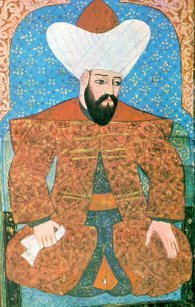
Orhan Ghazi was the second sultan of the Ottoman Empire from 1323/4 to 1362. He was born in Söğüt, as the son of Osman I.

The Karamanids, also known as the Emirate of Karaman and Beylik of Karaman, was one of the Anatolian beyliks, centered in South-Central Anatolia around the present-day Karaman Province. From the mid 14th century until its fall in 1487, the Karamanid dynasty was one of the most powerful beyliks in Anatolia.

The Candar dynasty or the House of Candar, Beylik of Candar, Principality of Candar, also known as the Isfendiyar dynasty (İsfendiyaroğulları) or Beylik of Isfendiyar, is an Oghuz Turkic princely Anatolian dynasty that reigned in the territories corresponding to the provinces of Eflani, Kastamonu, Sinop, Zonguldak, Bartın, Karabük, Samsun, Bolu, Ankara and Çankırı in present-day Turkey from the year 1291 to 1461. The region was known in Western literature as Paphlagonia, a name applied to the same geographical area during the Roman period.

Anatolian beyliks were small principalities in Anatolia governed by beys, the first of which were founded at the end of the 11th century. A second and more extensive period of establishment took place as a result of the decline of the Seljuq Sultanate of Rûm in the latter half of the 13th century.

Manisa, historically known as Magnesia, is a city in Turkey's Aegean Region and the administrative seat of Manisa Province, lying approximately 40 km northeast of the major city of İzmir.

The Germiyanids was a prominent Anatolian beylik established by the Oghuz Turkish tribes after the decline of Sultanate of Rûm. However, while the beylik was always mentioned as Turkoman or Oghuz Turkish, the population consisted of Turks and Yezidi Kurds, brought by the Seljuks from the east of Malatya to western Anatolia as militia guards against the threatening Turkish tribesmen.

The Aydinids or Aydinid dynasty, also known as the Principality of Aydin and Beylik of Aydin, was one of the Anatolian beyliks and famous for its seaborne raiding.

Menteshe was the first of the Anatolian beyliks, the frontier principalities established by the Oghuz Turks after the decline of the Seljuk Sultanate of Rum. Founded in 1260/1290, it was named for its founder, Menteshe Bey. Its capital city was Milas (Mylasa) in southwestern Anatolia.

The Anatolian beylik of Teke, with its capital at Antalya, was one of the frontier principalities established by Oghuz Turkish clans after the decline of the Seljuk Sultanate of Rûm.

The Eshrefids or Ashrafids was one of the Anatolian beyliks.

Alaiye (علائیه) is the medieval Seljuq name for Alanya. It refers to the city-state in a specific period and the beylik which developed around there, at times under the Karamanid dynasty. After the 1242 Battle of Köse Dağ, the Seljuqs lost control of the city, and it became semi-autonomous.

The House of Mengüjek was an Anatolian beylik of the first period, founded after the Battle of Manzikert. The Mengujekids ruled the regions of Erzincan, Kemah, Şebinkarahisar and Divriği in Eastern Anatolia in the 12th and 13th centuries.

The Ahi Brotherhood, referred to as Ahi Republic by modern historians, was a fraternity, guild and a beylik based in modern-day Ankara in the 13th and 14th century Anatolia.

Sarukhan (1300/01–1345/46) was a Turkish Bey of Magnesia.
Şehzade Halil was an Ottoman prince. His father was Orhan, the second bey of the Ottoman beylik. His mother was Theodora Kantakouzene, the daughter of Byzantine emperor John VI Kantakouzenos and Irene Asanina. His kidnapping was an important event in 14th century Ottoman-Byzantine relations. He was killed by his brother Murad I.
Yakup II of Germiyan also known as Yakup Çelebi, was the ruler of Germiyanids an Anatolian beylik between 1388 and 1429.
İlyas Bey was the second bey (lord) of the Turkish beylik of Saruhan in the 14th century.
Alaattin Ali of Karaman (d.1398), also Alaeddin Ali, was a bey of Karaman Beylik, a Turkish principality in Anatolia in the 14th century. Like most other Karaman beys, Ali Bey was a rival of the rising Ottoman Empire, and the two principalities engaged in chronic wars against one another.
İzzettin İsfendiyar Bey, was a member of the Candar dynasty that reigned as bey from 1385 until his death in 1440. Although the name of the dynasty is Candar, following his reign, as a testament to its longevity certain historians of the Ottoman Empire also began to refer to the beylik by the name İsfendiyar.














